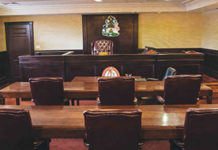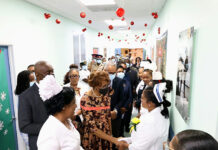
Members of the Antiquities, Monuments and Museums Corporation, Newport Collaborative Architects and Minister of State for Culture the Hon. Charles Maynard, centre, pose for an official photograph at Collins House on Thursday, February 14, 2008. (Photo/Tim Aylen)
By: Lindsay Thompson
NASSAU, Bahamas – The stage is set for the transformation of the historic former stately mansion Centreville, known as Collins House, as The Central Museum of The Bahamas, the Government announced Thursday.
At a press conference at the site on Collins Avenue and Shirley Street, Minister of State for Culture the Hon. Charles Maynard underscored the importance of preserving, restoring and transforming historic landmarks into national holdings.
“The Government of The Bahamas is committed to the redevelopment of the city of Nassau and the restoration of historical buildings. We are expecting to start the process of the adaptive reuse of Collins House,” he said.
The Bahamas Government, through the Antiquities, Monuments and Museums Corporation (AMMC), has partnered with consultants from the Newport Collaborative Architects (NCA), Inc., a group from Rhode Island in the United States, to transform Collins House. The group has been working since the 1970s in the preservation, sustainability and adaptive reuse of older buildings.
The partnership was formed about two years ago through the Rhode Island National Guard. The idea was imparted to the United States Embassy in Nassau and an exchange programme ensued in education and other areas, said Dr. Brent Hardt, Deputy Chief of Missions at the American Embassy.
Mr. Maynard said, “We are also committed to the establishment of a few national institutions, for example, the National Library of The Bahamas, the National Museum of The Bahamas and we thought that Collins House would be an excellent site for any of those projects.”
“The first step would be to determine the cost of restoration, the best use of the building, and this is the beginning of the process that the Newport Collaborative Architects would do for us; to help us present to the Government the full picture as to the viability of the adaptive reuse and the Government would make the final decision on what would be housed,” he said.
Alicia Oxley, consultant/preservation architect at the AMMC, said the Bahamian team of consultants would be working on the structural, plumbing and electrical and sprinkler engineering aspects of the project. Work is to begin early summer. Total restoration is expected to take about two years.
John Grosvenor, lead consultant of the NCA, said they noticed the similarities between Rhode Island and Nassau – historic buildings downtown, opportunities for a pedestrian accessible city, and mix-used buildings.
He hoped that the transformation of such historic buildings would improve the quality of life for Bahamians, like it did for residents in Rhode Island.
According to the Department of Archives, Collins House stands on the site of an older house, which was destroyed in the Hurricane of 1929. Ralph C. Collins, then a very prominent citizen, politician and businessman, built the present house shortly after the hurricane on the estate that stretches from Shirley Street to Wulff Road.
The building, along with a portion of the property, was acquired from the Collins Estate in 1950 by Saint Andrew’s School Limited to be used as a school. It was purchased by the Government in 1970 and was occupied by the Ministry of Education.







